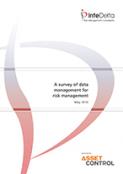Survey on Data Management for Risk Management
We surveyed major banks across the world to establish their data management practices and challenges. Two themes emerged – a move to a more centralised data management structure and the impact of regulation.
In regard to the centralisation debate:
- Banks are striving for a more centralised model to increase efficiency, cut costs and reduce operational risk
- There are differences in centralisation according to data type – as an example, our survey revealed that market data was the most centralised
- While many Tier 2 banks may view a completely centralised model as desirable and achievable, others are continuing with a silo based approach. For Tier 1 banks, the complexity of their operations often means that such a single data management function covering all data types , business functions and locations may not be possible, but they attempt to centralise as much as they can
In terms of drivers for change:
- Banks currently see regulation as being more important than internal drivers
- 85% of the banks we surveyed regarded regulation as a highly significant driver of change. BCBS 239 and the Fundamental Review of the Trading book were cited as the two most significant areas of regulation
- Both regulations put a strong emphasis on high quality data: while BCBS 239 focuses on data governance, data quality and reporting, the FRTB requires banks to perform more stringent risk calculations, resulting in a potential capital increase if those calculations fail


